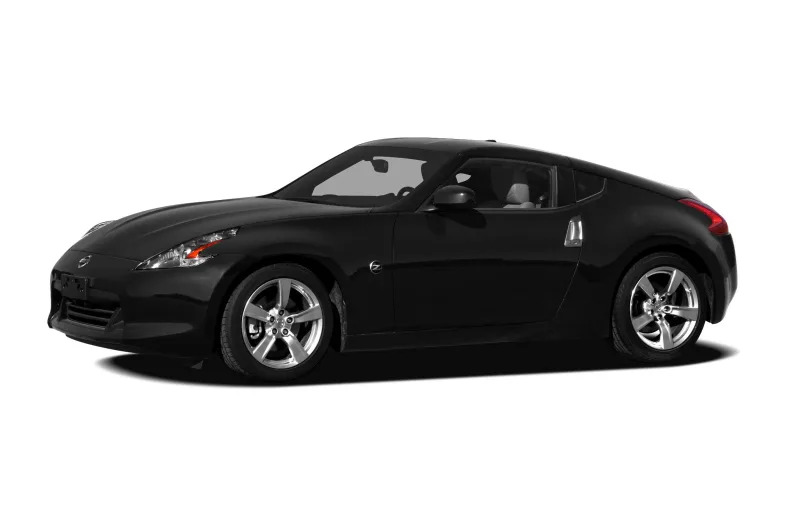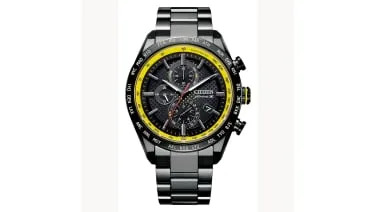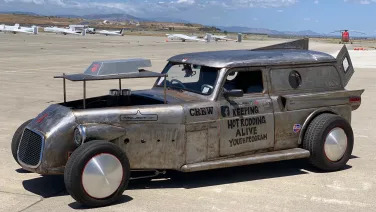2009 Nissan 370Z
Click above for high-res gallery of the 2009 Nissan 370Z Stand on any corner in any city, close your eyes and open your ears. Eventually you'll hear the telltale swell of an engine as someone blips the throttle while braking before the bend. This secret auditory handshake among gearheads signals the arrival of a driver schooled in the art of heel-and-toe. And when the 2009 Nissan 370Z goes on sale in January, you won't be able to tell an aspiring Schumacher from Joe the... shoemaker. Nissan's simple yet brilliant "SyncroRev Match" will relegate the artistry of rev-matching to the annals of motoring history. Other automakers compelled to offer manual gearboxes for the dedicated few will doubtlessly adopt the system, and those of us who care – who've unconsciously conditioned ourselves to crane our heads to catch a glimpse of what's coming – will cease to do so. Progress is a double-edged sword and rarely balanced, but don't fret. The 370Z's overly hyped rev-matching system isn't the end of the world, and it's hardly the best part of Nissan's new Z. Follow the jump to find out what is. %Gallery-39565% Photos copyright ©2008 Damon Lavrinc / Weblogs, Inc. The moment the first batch of Z spy shots surfaced, it was obvious that Nissan's sports car was on its way back from the gym. The coupe was wider, shorter and more sculpted, and when the wraps came off at the 2008 LA Auto Show, we finally had proof that at least one automaker gets "it." By "it" we mean lighter. And Nissan has succeeded – just. Although the Z's overall length has been shortened by 2.7 inches, the wheelbase cut by 3.9 inches and a set of aluminum doors join an aluminum hood and hatch, Nissan has only managed to shave 95 pounds from the curb weight of the standard model. Thanks to a wider track (0.5 inches up front and 2.2 inches in the rear), side curtain airbags and all of the other assorted equipment required by both the government and the public, the weight savings on the base 370Z is negligible, and the car will likely be heavier than its predecessor when kitted out in Touring trim. But the Z's 3,232-pound heft is used to good effect. Weight distribution remains 54/46 front-to-rear, and a lighter, stiffer aluminum front suspension cradle works in conjunction with a rear-mounted V-bar and a carbon composite radiator housing to stiffen the structure while keeping it light. The result is 30 percent more torsional rigidity up front, a 22-percent increase in the back and a 30-percent increase in vertical bending resistance in the rear. Combined with the new double-wishbone front suspension, redesigned four-link rear setup and new shock valving, the overall effect is – at first – mildly disconcerting. The 370Z eschews its predecessor's rickety ride for the kind of refinement you'd expect from a grand tourer. Puttering around town and mashing on the motorway, you get the sense that the 370Z has matured, dropping …
Full Review
Click above for high-res gallery of the 2009 Nissan 370Z Stand on any corner in any city, close your eyes and open your ears. Eventually you'll hear the telltale swell of an engine as someone blips the throttle while braking before the bend. This secret auditory handshake among gearheads signals the arrival of a driver schooled in the art of heel-and-toe. And when the 2009 Nissan 370Z goes on sale in January, you won't be able to tell an aspiring Schumacher from Joe the... shoemaker. Nissan's simple yet brilliant "SyncroRev Match" will relegate the artistry of rev-matching to the annals of motoring history. Other automakers compelled to offer manual gearboxes for the dedicated few will doubtlessly adopt the system, and those of us who care – who've unconsciously conditioned ourselves to crane our heads to catch a glimpse of what's coming – will cease to do so. Progress is a double-edged sword and rarely balanced, but don't fret. The 370Z's overly hyped rev-matching system isn't the end of the world, and it's hardly the best part of Nissan's new Z. Follow the jump to find out what is. %Gallery-39565% Photos copyright ©2008 Damon Lavrinc / Weblogs, Inc. The moment the first batch of Z spy shots surfaced, it was obvious that Nissan's sports car was on its way back from the gym. The coupe was wider, shorter and more sculpted, and when the wraps came off at the 2008 LA Auto Show, we finally had proof that at least one automaker gets "it." By "it" we mean lighter. And Nissan has succeeded – just. Although the Z's overall length has been shortened by 2.7 inches, the wheelbase cut by 3.9 inches and a set of aluminum doors join an aluminum hood and hatch, Nissan has only managed to shave 95 pounds from the curb weight of the standard model. Thanks to a wider track (0.5 inches up front and 2.2 inches in the rear), side curtain airbags and all of the other assorted equipment required by both the government and the public, the weight savings on the base 370Z is negligible, and the car will likely be heavier than its predecessor when kitted out in Touring trim. But the Z's 3,232-pound heft is used to good effect. Weight distribution remains 54/46 front-to-rear, and a lighter, stiffer aluminum front suspension cradle works in conjunction with a rear-mounted V-bar and a carbon composite radiator housing to stiffen the structure while keeping it light. The result is 30 percent more torsional rigidity up front, a 22-percent increase in the back and a 30-percent increase in vertical bending resistance in the rear. Combined with the new double-wishbone front suspension, redesigned four-link rear setup and new shock valving, the overall effect is – at first – mildly disconcerting. The 370Z eschews its predecessor's rickety ride for the kind of refinement you'd expect from a grand tourer. Puttering around town and mashing on the motorway, you get the sense that the 370Z has matured, dropping …
Hide Full Review
Hide Full Review
Retail Price
$29,930 - $39,130
MSRP / Window Sticker Price
| Engine | 3.7L V-6 |
| MPG | Up to 18 city / 26 highway |
| Seating | 2 Passengers |
| Transmission | 6-spd man w/OD |
| Power | 332 - 350 hp |
| Drivetrain | rear-wheel |
| Curb Weight | 3,232 - 3,300 lbs |
Smart Buy Program is powered by 






